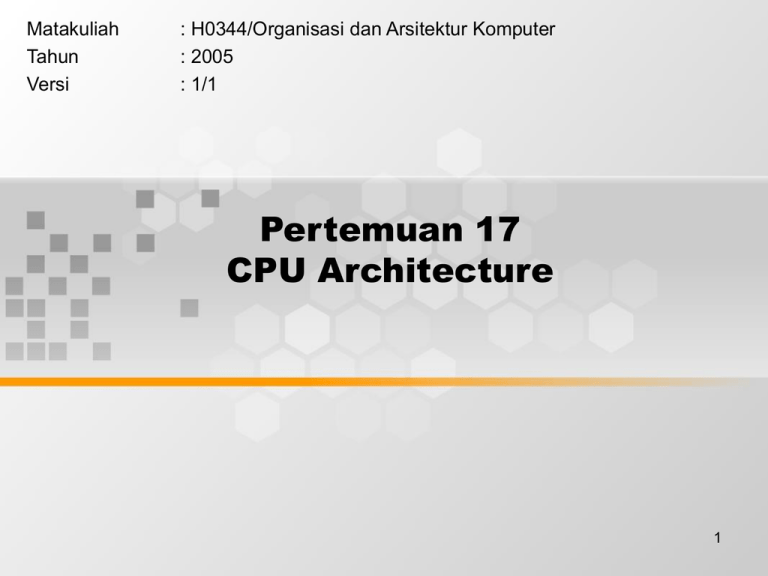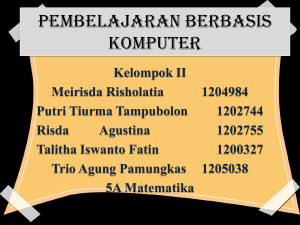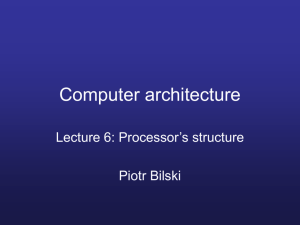Pertemuan 17 CPU Architecture Matakuliah : H0344/Organisasi dan Arsitektur Komputer
advertisement

Matakuliah Tahun Versi : H0344/Organisasi dan Arsitektur Komputer : 2005 : 1/1 Pertemuan 17 CPU Architecture 1 Learning Outcomes Pada akhir pertemuan ini, diharapkan mahasiswa akan mampu : • Menjelaskan konsep dasar CPU architecture 2 Outline Materi • • • • Processor Organization Register Organization Instruction Cycle Instruction Pipelining 3 Processor Organization CPU must do: • Fetch instruction • Interpret instruction • Fetch data • Process data • Write data 4 Processor Organization The CPU with the system bus Registers ALU Control unit Control bus Data bus Address bus System bus 5 Processor Organization Internal structure of the CPU Arithmetic and logic unit Status flags Shifter Complementer Arithmetic and boolean logic Internal CPU bus Registers Control unit Control path 6 Register Organization The registers in the CPU perform two rules: • User visible registers • Control and status registers User visible registers We can characterize user visible registers in the following categories: • General purpose • Data • Address • Condition codes 7 Register Organization Control and status registers Four registers are essential to instruction execution: • Program counter • Instruction register • Memory address register • Memory buffer register 8 Register Organization Control and status registers All CPU designs include a register or set registers, often know as the program status word (PSW), that contain status information. These status include the following: • Sign • Zero • Carry • Equal • Overflow • Interrupt enable/disable • Supervisor 9 Instruction Cycle Instruction Cycle Fetch Interrupt Indirect Execute 10 Instruction Cycle Instruction Cycle State Diagram Instruction fetch Operand fetch Operand store Multiple operands Instruction address calculation Instruction operation decoding Instruction complete, fetch next instruction Operand address calculation Multiple result Data operation Operand address calculation Return for string or vector data 11 Instruction Cycle Data Flow in Fetch Cycle PC MAR Memory Control unit IR MBR Address bus Data bus Control bus 12 Instruction Cycle Data Flow in Indirect Cycle MAR Memory Control unit MBR Address bus Data bus Control bus 13 Instruction Cycle Data Flow in Interrupt Cycle MAR PC Memory Control unit MBR Address bus Data bus Control bus 14 Instruction Pipelining The following decomposition of the instruction processing • Fetch instruction (FI) • Decode instruction (DI) • Calculate operands (CO) • Fetch Operands (FO) • Execute instruction (EI) • Write operand (WO) 15 Instruction Pipelining Fetch instruction Six stage CPU instruction pipeline Decode instruction Calculate operands Unconditional branch? Fetch operands Execute instruction Write operands Update PC Empty pipe Unconditional or interrupt? 16 FI DI CO FO EI 1 I1 2 I2 I1 3 I3 I2 I1 4 I4 I3 I2 I1 5 I5 I4 I3 I2 I1 6 I6 I5 I4 I3 I2 7 I7 I6 I5 I4 8 I8 I7 I6 9 I9 I8 I9 10 11 12 WO FI DI CO FO EI WO 1 I1 2 I2 I1 3 I3 I2 I1 4 I4 I3 I2 I1 5 I5 I4 I3 I2 I1 I1 6 I6 I5 I4 I3 I2 I1 I3 I2 7 I7 I6 I5 I4 I3 I2 I5 I4 I3 8 I15 I7 I6 I5 I4 9 I16 I8 I7 I6 I5 10 I9 I8 I7 I6 11 I9 I8 I7 12 I9 I8 13 I9 14 13 14 I3 I15 I16 I15 I16 I15 I16 I15 I16 I15 I16 17 (a) No branches (b) With conditional branch Instruction Pipelining A variety of approaches have been taken for dealing with conditional branches: • Multiple streams • Prefetch branch target • Loop buffer • Branch prediction • Delayed branch 18 Instruction Pipelining Various techniques can be used to predict whether a branch will be taken. Among the more common are the following: • Predict never taken • Predict always taken • Predict by opcode • Taken/not taken switch • Branch history table 19 Instruction Pipelining Branch prediction flowchart Yes Read next conditional branch instruction Read next conditional branch instruction Predict taken Predict not taken No Branch taken? Branch taken? No Yes Read next conditional branch instruction Read next conditional branch instruction Predict taken Predict not taken Yes No Branch taken? No Branch taken? Yes 20 Instruction Pipelining Branch prediction state diagram Not taken Taken Predict taken Predict taken Taken Taken Not taken Not taken Predict not taken Predict not taken Not taken Taken 21 Instruction Pipelining Dealing with Branches Branch instruction address E Target address State IPFAR Next sequential address Branch miss handling Add new entry E Branch miss handling Select Next sequential address Update state Redirect Select Memory Memory (a) Predict never taken strategy (a) Branch history table strategy 22


